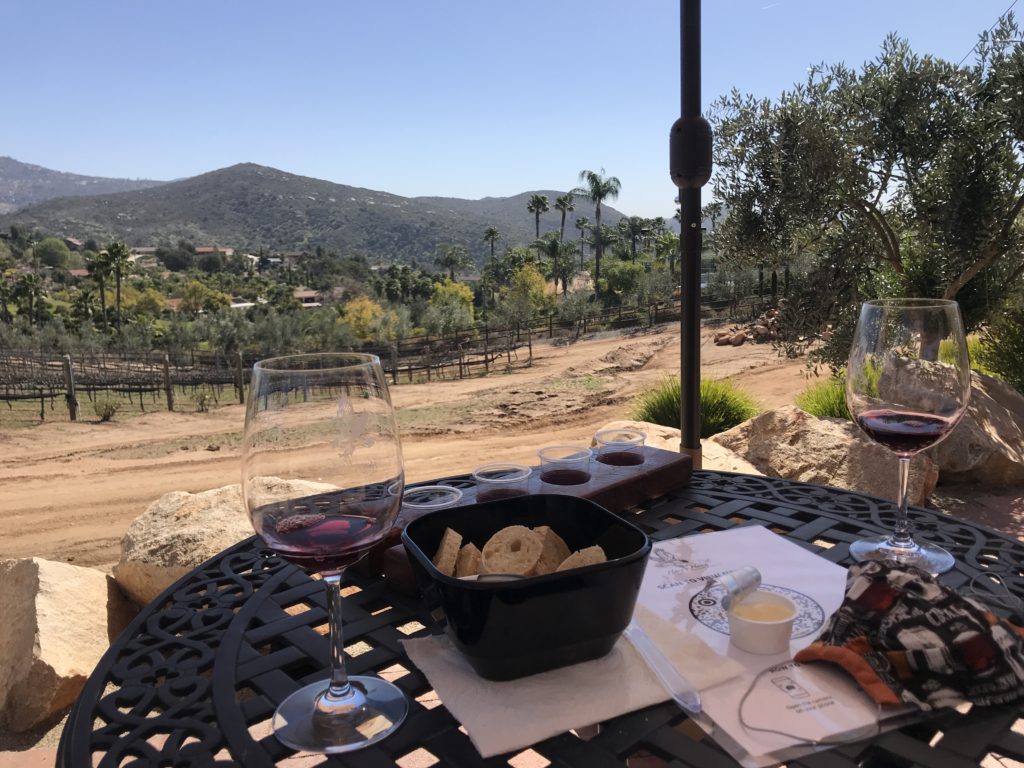In February, we traveled to Ramona, CA to hike in nearby state and federal parks. Upon arrival we found ourselves in a boutique wine making region. The Ramona Valley American Viniculture Area (AVA) was established in 2006 because of its unique microclimate, terroir, and history for grape production. At the time of our visit there were over 30 wineries with more coming each year. Our immediate reaction, being wine snobs and all, was “none of this can be any good”. We were quite wrong. The region is still relatively new but very much up-and-coming with many wineries making unique and interesting wines. In many ways it is reminiscent of the Finger Lakes wineries 25 years ago except they have the soil and weather to make solid reds.
The climate is arid compared to most other California regions. It closely resembles the Mediterranean area for heat and dryness. The soil is heavily granite based. Consequently, many of the grapes from Italy, Spain, France, and Greece thrive in Ramona and are preferred by the local winemakers.
We tasted wine at ten carefully chosen wineries over four days and thoroughly enjoyed it. The AVA isn’t very big so it was easy to get around, although some were down long dirt roads. The wineries are generally small boutique operations of less than 1000 cases annually and are run by the owners. Many of the owners are also the winemakers. Most of the tasting rooms are open only on the weekends. When they are open, the owners/winemakers are often serving wine and/or visiting with customers. This made for some great tasting experiences as we explored this new-to-us AVA. As with any wine region, the wine quality varies greatly from winery-to-winery, as well as, over a wineries’ lineup. A summary of impressions, opinions, and take-aways:
- It seems to be difficult to make a decent white in this climate – we only purchased a few of the whites
- The red wines are light and subtle – there were no fruit bombs
- We did not find any Zins that we liked (and you know Suzanne is a Zin fan)
- Both red and white wines are very dry, sometimes to the point of being sour when young
- Many of the reds need a few years on the rack before drinking
- These wines are probably at their best when consumed with food instead of just “sipping” alone
- Prices are quite a bit lower than other CA regions we are familiar with including Sonoma and Paso Robles – most red list prices were in the $30’s, whites in the $20’s
The Ramona wine region was a very pleasant surprise and one we expect to revisit in a few years. We look forward to see how it changes and progresses. Our tasting wrap-up can be viewed on the link below.





















did you check out any wineries that participate in Harvest Hosts? Not to stay overnight at per se, but to take a “look-see” how they implement the harvest Host business model?
Hatfield Creek, one of the ten wineries we were at, was a Harvest Host. They had a large parking lot reserved for RVs to dry camp. That is not to be confused with a parking lot for large RVs. The Tasting Room host told me that our RV was too big. He also told me they sometimes get a dozen RVs and the noise from all the generators in the evening is deafening. When we were there, two RVs were already set up and another arrived while we were tasting. If you were to arrive early in the day, you could get a great spot overlooking the vineyards. There are a few more details in the Ramona Wine Wrap-up.